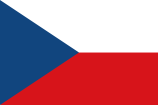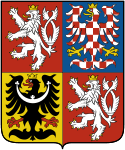Czech Republic
| Czech Republic
Česká republika
|
||||||
|---|---|---|---|---|---|---|
|
||||||
| Motto: "Pravda vítězí" (Czech) "Truth prevails" |
||||||
| Anthem: Kde domov můj? (in English: Where is my home?) |
||||||
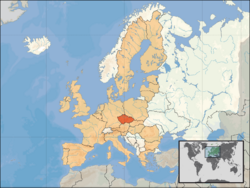 Location of the Czech Republic (orange)
– on the European continent (camel & white) |
||||||
| Capital (and largest city) |
Prague |
|||||
| Official languages | Czech | |||||
| Demonym | Czech | |||||
| Government | Parliamentary republic | |||||
| - | President | Václav Klaus | ||||
| - | Prime Minister | Mirek Topolánek | ||||
| Independence | (formed cca 870) | |||||
| - | from Austria-Hungary | October 28, 1918 | ||||
| - | Czechoslovakia dissolved | January 1, 1993 | ||||
| EU accession | May 1, 2004 | |||||
| Area | ||||||
| - | Total | 78,866 km2 (117th) 30,450 sq mi |
||||
| - | Water (%) | 2 | ||||
| Population | ||||||
| - | 20081 estimate | ▲10,424,926 (78th) | ||||
| - | 2001 census | 10,230,060 | ||||
| - | Density | 132/km2 (77th) 341/sq mi |
||||
| GDP (PPP) | 2007 estimate | |||||
| - | Total | $250.057 billion[1] (39th²) | ||||
| - | Per capita | $24,229[1] (35th) | ||||
| GDP (nominal) | 2007 estimate | |||||
| - | Total | $174.999 billion[1] (39th) | ||||
| - | Per capita | $16,956[1] (36th) | ||||
| Gini (1996) | 25.4 (low) (5th) | |||||
| HDI (2005) | ▲0.891 (high) (32nd) | |||||
| Currency | Czech koruna (CZK) |
|||||
| Time zone | CET (UTC+1) | |||||
| - | Summer (DST) | CEST (UTC+2) | ||||
| Drives on the | right | |||||
| Internet TLD | .cz³ | |||||
| Calling code | +4204 | |||||
| 1 | June 30, 2008 (See Population changes - 1st half of 2008). | |||||
| 2 | Rank based on 2005 IMF data. | |||||
| 3 | Also .eu, shared with other European Union member states. | |||||
| 4 | Shared code 42 with Slovakia until 1997. | |||||
The Czech Republic [ˈtʃɛk rɪˈpʌblɪk][2] (Czech: Česká republika (help·info), IPA: [ˈt͡ʃɛskaː ˈrɛpuˌblɪka], short form in Czech: Česko, IPA: [ˈt͡ʃɛskɔ]), is a landlocked country in Central Europe and a member state of the European Union. The country borders on Poland to the northeast, Germany to the west, Austria to the south, and Slovakia to the east. The capital and largest city is Prague (Czech: Praha). The country is composed of the historic regions of Bohemia and Moravia, as well as parts of Silesia.
Following the Battle of Mohács, the Czech lands fell under Habsburg rule from 1526, later becoming part of the Austrian Empire and Austria-Hungary. The independent Republic of Czechoslovakia was formed in 1918, following the collapse of the Austro-Hungarian empire after World War I. After the Munich Agreement, German occupation of Czechoslovakia and the consequent disillusion with the Western response and gratitude for the liberation of the major portion of Czechoslovakia by the Red Army, the Communist party won plurality (38%)[3] in 1946 elections. In an 1948 coup d'état, Czechoslovakia became a communist-ruled state. In 1968, the increasing dissatisfaction culminated in attempts to reform the communist regime. The events, known as the Prague Spring of 1968, ended with an invasion by armies of Warsaw Pact countries, and the troops remained in the country until the overturn in 1989 Velvet Revolution, when the communist regime collapsed. On January 1, 1993 Czechoslovakia peacefully dissolved into its constituent states, the Czech Republic and Slovakia.
The Czech Republic is a pluralist multi-party parliamentary representative democracy. President Václav Klaus is the current head of state. The Prime Minister is the head of government (currently Mirek Topolánek). The Parliament has two chambers — the Chamber of Deputies and the Senate. The Czech Republic joined NATO in 1999 and the European Union in 2004. It is also a member of the OECD, the Council of Europe and the Visegrád Group.
The Czech Republic made economic reforms such as fast privatization and flat tax. Annual gross domestic product growth has recently been around 6%. The country is the first former member of the Comecon to achieve the status of a developed country (2006) according to the World Bank.[4] The Czech Republic also ranks best compared to the former Comecon countries in the Human Development Index.[5]
Contents |
Name
- See also: Names of the Czech Republic and Czech lands
The English spelling Czech derives from the Polish spelling of the original Čech.[6] Following the dissolution of Czechoslovakia, the Czech half of the former nation found itself without a common single-word name in English. In 1993, the Czech Ministry of Foreign Affairs suggested the name Czechia as an official alternative in all situations other than formal official documents and the full names of government institutions; however, this has not become widespread despite the fact most other languages have single-word names for the nation.
History


Archaeologists have found evidence of prehistoric human settlement in the area dating back to the Neolithic era. In the classical era, from the 3rd century BC Celtic migrations, the Boii (see Bohemia) and later in the 1st century Germanic tribes of Marcomanni and Quadi settled there. During the Migration Period around the 5th century, many Germanic tribes moved westwards and southwards out of Central Europe. In an equally significant migration, Slavic people from the Black Sea and Carpathian regions settled in the area (a movement that was also stimulated by the onslaught of peoples from Siberia and Eastern Europe: Huns, Avars, Bulgars and Magyars). Following in the Germans' wake, they moved southwards into Bohemia, Moravia, and some of present day Austria. During the 7th century the Frankish merchant Samo, supporting the Slavs fighting their Avar rulers, became the ruler of the first known Slav state in Central Europe. The Moravian principality arose in the 8th century (see Great Moravia). The Bohemian or Czech state emerged in the late 9th century when it was unified by the Přemyslid dynasty. The kingdom of Bohemia was a significant regional power during the Middle Ages. It was part of the Holy Roman Empire during the entire existence of this confederation.[8]
In 1212 King Přemysl Otakar I (1198-1230), bearing the title “king“ already since 1198, extracted a Golden Bull of Sicily (a formal edict) from the emperor confirming the royal title for Otakar and his descendants. The 13th century was also a period of large-scale German immigration. The Germans populated towns and mining districts on the Bohemian periphery and in some cases formed German colonies in the interior of the Czech lands. In 1241 the mighty Mongol army launched an invasion into Europe, and after the Battle of Legnica the Mongols carried their devastating raid into Moravia.[9] The King Přemysl Otakar II (1253–1278), earned the nickname of “the King of Gold and Iron” due to his military power and wealth. He met his death at the Battle on the Marchfeld in 1278 in a war with his rival, the Roman king Rudolph I of Habsburg.[10] In 1306, the Přemyslid line had died out, and, after a series of dynastic wars, a new Luxemburg dynasty captured the Bohemian crown. The 14th century, particularly the reign of Charles IV (1342-1378), is considered the Golden Age of Czech history. Of particular significance was the founding of Charles University in Prague in 1348. The Black Death which had raged in Europe from 1347-1352 decimated the Kingdom of Bohemia in 1380.[11]

Religious conflicts such as the 15th century Hussite Wars and the 17th century Thirty Years' War had a devastating effect on the local population. From the 16th century, Bohemia came increasingly under Habsburg control as the Habsburgs became first the elected and then hereditary rulers of Bohemia. Czechs call the period from 1620 (the Battle of White Mountain) till the late 18th century, the "Dark Age". The population of the Czech lands declined by a third due to war, disease, famine and the expulsion of Protestant Czechs.[12] The Habsburgs banned all religions other than Catholicism.[13] Ottoman Turks and Tatars invaded Moravia in 1663, taking 12,000 slaves.[14]
The reigns of Maria Theresa (1740-80) and her son Joseph II (1780-90), Holy Roman Emperor and co-regent from 1765, were characterized by enlightened rule. In 1742, most of Silesia (then the possession of the Bohemian crown) was seized by King Frederick the Great of Prussia in the War of the Austrian Succession. After the fall of the Holy Roman Empire, Bohemia became part of Austrian Empire and later of Austria-Hungary. The Great Famine, which lasted from 1770 until 1771, killed 12% of Czech lands’ population, up to 500,000 inhabitants, and radicalized countrysides leading to peasant uprisings. Serfdom was not completely abolished until 1848. After the revolutions of 1848, Emperor Franz Joseph attempted to rule as an absolute monarch, keeping all the nationalities in check.
Czechoslovakia
An estimated 150,000 Czech soldiers died in World War I.[15] Following the collapse of the Austro-Hungarian Empire after World War I, the independent republic of Czechoslovakia was created in 1918. This new country incorporated regions of Bohemia, Moravia, Silesia, Slovakia and Carpathian Ruthenia (known as Subcarpathian Rus at the time) with significant German, Hungarian, Polish and Ruthenian speaking minorities.[16] Although Czechoslovakia was a unitary state, it provided what were at the time rather extensive rights to its minorities. However, it did not grant its minorities any territorial political autonomy. The failure to do this resulted in discontent and strong support among some of the minorities for a break from Czechoslovakia. Adolf Hitler took advantage of this opportunity and, supported by Konrad Henlein's Sudeten German National Socialist Party, gained the largely German speaking Sudetenland through the 1938 Munich Agreement. Poland annexed Polish inhabited areas around Český Těšín. Hungary gained parts of Slovakia and Subcarpathian Rus as a result of the First Vienna Award in November 1938.
The remainders of Slovakia and Subcarpathian Rus gained greater autonomy, with the state renamed to "Czecho-Slovakia" (The Second Republic; see Occupation of Czechoslovakia). Slovakia seceded in March 1939 and allied itself with Hitler's coalition. The remaining Czech territory was occupied by Germany, which transformed it into the so-called Protectorate of Bohemia and Moravia. The Protectorate was proclaimed part of the Third Reich, and President and Prime Minister were subordinate to the Nazi Reichsprotektor ("imperial protector"). Subcarpathian Rus declared independence as the Republic of Carpatho-Ukraine on 15 March 1939 but was invaded by Hungary the same day and formally annexed on 16 March. Approximately 390,000 Czechoslovak citizens, including 83,000 Jews, were killed or executed, and hundreds of thousands of others were sent to prisons and concentration camps or used as forced labour. A Nazi concentration camp existed at Terezin to the north of Prague. There was Czech resistance to Nazi occupation both at home and abroad, most notably with the assassination of Nazi leader Reinhard Heydrich in a Prague suburb on May 27, 1942. The Czechoslovak government-in-exile and its army fighting against the Germans were acknowledged by the Allies (Czechoslovak troops fought in Great Britain, North Africa, Middle East and Soviet Union). The occupation ended on 9 May 1945 with the arrival of Soviet and American armies and the Prague uprising.
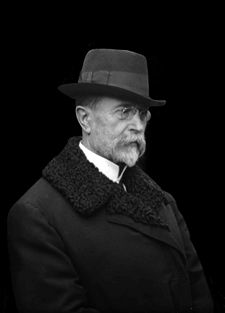
In 1945-46 almost the entire German minority in Czechoslovakia, about 2.7 million people, were expelled to Germany and Austria. During this time, thousands of Germans were held in prisons and detention camps, or used as forced labour. In the summer of 1945 there were several massacres. The only Germans not expelled were some 250,000 who had been active in the resistance against the Nazis or were considered economically important, though many of these emigrated later. Following a Soviet-organised referendum, the Subcarpathian Rus never returned under Czechoslovak rule but became part of the Ukrainian SSR as the Zakarpattia Oblast in 1946.
Czechoslovakia uneasily tried to play the role of a "bridge" between the West and East. However the Communist Party of Czechoslovakia rapidly increased in popularity, with a general disillusionment with the West (due to the pre-war Munich Agreement) and a favourable popular attitude towards the Soviet Union (due to the Soviets' role in liberating Czechoslovakia from German rule). In the 1946 elections the Communists gained 38% of the votes and became the largest party in the Czechoslovak parliament. They formed a coalition government with other parties of the National Front, and moved quickly to consolidate power. The decisive step took place in February 1948. During a series of events characterized by Communists as a "revolution" and by anti-Communists as a "takeover", the Communist People's Militias secured control of key locations in Prague, and a new, all-Communist government was formed.
For the next 41 years, Czechoslovakia was a Communist state within the eastern bloc (see Czechoslovakia: 1948-1989). This period was marked by a variety of social developments. The Communist government completely nationalized the means of production and established a command economy. The economy grew rapidly during the 1950s and 1960s, but slowed down in the 1970s, with increasing problems during the 1980s. The political climate was highly repressive during the 1950s (including numerous show trials) but became more open and tolerant in the 1960s, culminating in Alexander Dubček's leadership in the 1968 Prague Spring that tried to create "socialism with a human face" and perhaps even introduce political pluralism. This was forcibly ended by the 21 August 1968 Warsaw Pact invasion.
The invasion was followed by a harsh program of "Normalization" in the late 1960s and the 1970s. Until 1989, the political establishment relied on censorship of the opposition, though using more "carrot" than "whip" to secure the populace's passivity. Dissidents published Charter 77 in 1977 and the first of a new wave of protests were seen in 1988.
Velvet revolution and the Czech Republic
In November 1989, Czechoslovakia returned to democracy through a peaceful "Velvet Revolution". However Slovak national aspirations strengthened, until on January 1, 1993 the country peacefully split into the independent Czech Republic and Slovakia. Both countries went through economic reforms and privatisations, with the intention of creating a market economy.
Voters embraced rapid economic reforms, and their success enabled the Czech Republic to become the first post-communist country to receive an investment-grade rating from international credit rating agencies. Most state-owned heavy industries were privatized through voucher privatization systems. The Czech Republic saw modest budget deficits, low unemployment, a positive balance of payments, a stable exchange rate, and a shift of exports from former communist economic bloc markets to Western Europe. The most important change since 1989 has been the return of the right to own property.
From 1991 the Czech Republic (originally as part of Czechoslovakia, and now in its own right) has been a member of the Visegrad Group and from 1995 of the OECD. The Czech Republic joined NATO on March 12, 1999 and the European Union on May 1, 2004.
Geography




- See also: Protected Areas of the Czech Republic
The Czech landscape is quite varied. Bohemia to the west consists of a basin drained by the Elbe (Czech: Labe) and the Vltava (or Moldau) rivers, and surrounded by mostly low mountains such as the Krkonoše range of the Sudetes. The highest point in the country, Sněžka, at 1,602 m (5,262 ft), is located here. Moravia, the eastern part of the country, is also quite hilly. It is drained mainly by the Morava River, but it also contains the source of the Oder (Czech: Odra) River. Water from the landlocked Czech Republic flows to three different seas: the North Sea, Baltic Sea and Black Sea. The Czech Republic also leases the Moldauhafen, a 30,000-square-metre (7.4-acre) lot in the middle of the Hamburg Docks, which was awarded to Czechoslovakia by Article 363 of the Treaty of Versailles to allow the landlocked country a place where goods transported down river could be transferred to seagoing ships. The territory reverts to Germany in 2028.
Phytogeographically, the Czech Republic belongs to the Central European province of the Circumboreal Region within the Boreal Kingdom. According to the WWF, the territory of the Czech Republic can be subdivided into four ecoregions: the Central European mixed forests, Pannonian mixed forests, Western European broadleaf forests and Carpathian montane conifer forests.
Weather and climate
The Czech Republic has a temperate continental climate with relatively hot summers and cold, cloudy winters, usually with snow. Most rain falls during the summer. The temperature difference between summers and winters is relatively high due to the landlocked geographical position.
Within the Czech Republic, temperatures vary greatly depending on the elevation. In general, at higher altitudes the temperatures decrease and precipitation increases. Another important factor is the distribution of the mountains. Therefore the climate is quite varied.
At the highest peak (Sněžka, 1,602 m/5,260 ft) the average temperature is only −0.4 °C (31 °F), whereas in the lowlands of South Moravia, the average temperature is as high as 10 °C (50 °F). The country's capital Prague has a similar average temperature, although this is influenced by urban factors.
The coldest month is usually January, followed by February and December. During these months there is usually snow in the mountains and sometimes in the major cities and lowlands. During March, April and May, the temperature usually increases rapidly, and especially during April the temperature and weather tends to vary widely during the day. Spring is also characterized by high water levels in the rivers due to melting snow, with occasional floods.
The warmest month of the year is July, followed by August and June. On average, summer temperatures are about 20 Celsius or 36 Fahrenheit degrees higher than during winter. Especially in the last decade, temperatures above 30 °C (86 °F) are not unusual. Summer is also characterized by rain and storms.
Autumn generally begins in September, which is still relatively warm, but much drier. During October, temperatures usually fall below 15° or 10°C (59° or 50°F) and deciduous trees begin to shed their leaves. By the end of November, temperatures usually range around the freezing point.
Demographics
Population
| Year | Total | Change | Year | Total | Change |
|---|---|---|---|---|---|
| 1857 | 7,016,531 | — | 1930 | 10,674,386 | 6.6% |
| 1869 | 7,617,230 | 8.6% | 1950 | 8,896,133 | -16.7% |
| 1880 | 8,222,013 | 7.9% | 1961 | 9,571,531 | 7.6% |
| 1890 | 8,665,421 | 5.4% | 1970 | 9,807,697 | 2.5% |
| 1900 | 9,372,214 | 8.2% | 1980 | 10,291,927 | 4.9% |
| 1910 | 10,078,637 | 7.5% | 1991 | 10,302,215 | 0.1% |
| 1921 | 10,009,587 | -0.7% | 2001 | 10,230,060 | -0.7% |
The vast majority of the inhabitants of the Czech Republic are Czechs (94.2%). Minorities include the Slovaks (1.9%), Poles (0.5%), Vietnamese (0.44%), Germans (0.4%), and Gypsies.[18] According to the Interior Ministry of the Czech Republic, there were 392,087 foreigners legally residing in the country at the end of 2007, making up 3.2% of the population, with the largest groups being Ukrainians and Slovaks.[19] The Czech Republic is home to between 250,000 and 300,000 Roma, who make up the country's second largest minority population after Slovaks.[20][21]
The fertility rate was low at 1.44 children born/woman. In 2007, immigration increased the population by almost 1%.
According to the Czech Statistics Office (Foreigners in the CR, top 5 of citizenships - 31.5.2008), 126,613 Ukrainians, 71,591 Slovaks, 55,991 Vietnamese, 24,549 Russians and 21,092 Poles lived in the Czech Republic in 2008.[22] At present, there are almost 6,000 legally working Mongolians in the Czech Republic.[23]
Religion
The Czech Republic, along with Estonia, has one of the least religious populations in all of Europe. According to the 2001 census, 59% of the country is agnostic, atheist, a non-believer or a non-organized believer, 26.8% Roman Catholic and 2.5% Protestant.[24]
According to the most recent Eurobarometer Poll 2005,[25] 19% of Czech citizens responded that "they believe there is a God" (the second lowest rate among EU countries after Estonia with 16%),[26] whereas 50% answered that "they believe there is some sort of spirit or life force" and 30% that "they do not believe there is any sort of spirit, God, or life force".
Politics

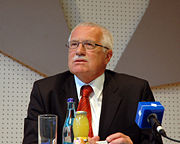
Political system
The Czech Republic is a pluralist multi-party parliamentary representative democracy, with the Prime Minister as head of government. The Parliament (Parlament České republiky) is bicameral, with the Chamber of Deputies (Czech: Poslanecká sněmovna) (200 members) and the Senate (Senát)(81 members).
The President of the Czech Republic is elected by joint session of the parliament for a five-year term (no more than two consecutive terms). The president is a formal head of state with limited specific powers, most importantly to return bills to the parliament, nominate Constitutional Court judges for the Senate's approval, and dissolve the parliament under certain special and unusual circumstances. He also appoints the prime minister as well the other members of the cabinet on a proposal by the prime minister. Václav Klaus, now President of the Czech Republic, former Prime Minister and chairman of Civic Democrats (ODS), remains one of the country's most popular politicians.
The Prime Minister is the head of government and wields considerable powers, including the right to set the agenda for most foreign and domestic policy, mobilize the parliamentary majority, and choose government ministers.
The members of the Chamber of Deputies are elected for a four year term by proportional representation with a 5% election threshold. There are 14 voting districts identical to the country's administrative regions. The Chamber of Deputies, the successor to the Czech National Council, has the powers and responsibilities of the now defunct federal parliament of the former Czechoslovakia.
The members of the Senate are elected in single-seat constituencies by two-round runoff voting for a six-year term, with one-third elected every even year in the autumn. The first election was 1996 (for differing terms). This arrangement is modelled on the U.S. Senate, but each constituency is (roughly) the same size and the voting system used is a two-round runoff. The Senate is unpopular among the public and suffers from low election turnout (overall roughly 30% in the first round, 20% in the second).
Foreign policy
- See also: Foreign relations of the Czech Republic
Membership in the European Union is central in Czech Republic's foreign policy, and the Czech Republic will take over the presidency of the European Union for the first half of 2009.
According to The Economist, the Czech Republic has earned "a reputation for promoting human rights at every turn". Czech officials have supported dissents everywhere from Burma to Belarus, Moldova and Cuba.[27]
Czech Republic is motivated by its experience of Nazi and communist oppression. Also, the country's first post-communist president Václav Havel is an ex-dissident writer, who has set a moral example and has attracted ex-dissidents to key government positions.[27] For example, every March since 2003, when Fidel Castro locked up 75 political opponents, activists have set up a cage in Wenceslas Square representing a Cuban prison cell. Frequent prison uniform-wearing protesters have included distinguished individuals such as the foreign minister, the mayor of Prague and musical stars.[27]

Some EU officials have been irritated by Czech Republic's activism in human rights. Czech Republic, and other countries emphasising human rights, have been in conflicts with EU countries who favour closer ties with dictatorships such as Cuba or Burma.[27]
Armed forces
The Czech armed forces consist of the Army and Air Force and of specialized support units. In 2004, the Czech armed forces completely phased out conscription and transformed into a fully professional army and air force. The country has been a member of NATO since March 12, 1999. Defence spending is around 1.8% of GDP (2006).
Regions and districts
Since 2000, the Czech Republic is divided into thirteen regions (Czech: kraje, singular kraj) and the capital city of Prague. Each region has its own elected Regional Assembly (krajské zastupitelstvo) and hejtman (usually translated as hetman or "president"). In Prague, their powers are executed by the city council and the mayor.
The older seventy-six districts (okresy, singular okres) including three 'statutory cities' (without Prague, which had special status) lost most of their importance in 1999 in an administrative reform; they remain as territorial divisions and seats of various branches of state administration.[28]


| (Lic. plate) | Region | Capital | Population (2004 est.) | Population (2008 est.) |
|---|---|---|---|---|
| A | Prague, the Capital City (Hlavní město Praha) | 1,170,571 | 1,223,368 | |
| S | Central Bohemian Region (Středočeský kraj) | offices located in Prague (Praha) | 1,144,071 | 1,214,356 |
| C | South Bohemian Region (Jihočeský kraj) | České Budějovice | 625,712 | 634,408 |
| P | Plzeň Region (Plzeňský kraj) | Pilsen (Plzeň) | 549,618 | 565,029 |
| K | Karlovy Vary Region (Karlovarský kraj) | Karlovy Vary | 304,588 | 308,450 |
| U | Ústí nad Labem Region (Ústecký kraj) | Ústí nad Labem | 822,133 | 835,260 |
| L | Liberec Region (Liberecký kraj) | Liberec | 427,563 | 435,755 |
| H | Hradec Králové Region (Královéhradecký kraj) | Hradec Králové | 547,296 | 553,503 |
| E | Pardubice Region (Pardubický kraj) | Pardubice | 505,285 | 513,949 |
| M | Olomouc Region (Olomoucký kraj) | Olomouc | 635,126 | 641,897 |
| T | Moravian-Silesian Region (Moravskoslezský kraj) | Ostrava | 1,257,554 | 1,250,066 |
| B | South Moravian Region (Jihomoravský kraj) | Brno | 1,123,201 | 1,143,389 |
| Z | Zlín Region (Zlínský kraj) | Zlín | 590,706 | 591,026 |
| J | Vysočina Region (Vysočina) | Jihlava | 517,153 | 514,470 |
Economy

The Czech Republic possesses a developed,[29] high-income[30] economy with a GDP per capita of 82% of the European Union average. One of the most stable and prosperous of the post-Communist states, the Czech Republic has seen a growth of over 6% annually in the last three years. Recent growth has been led by exports to the European Union, especially Germany, and foreign investment, while domestic demand is reviving.
Most of the economy has been privatized, including banks and telecommunications. The current right-center government plans to continue with privatization, including the energy industry and the Prague airport. It has recently agreed to the sale of a 7% stake of the energy producer ČEZ, with the sale of the Budějovický Budvar brewery also mooted.

The country has fully implemented the Schengen Agreement and therefore has abolished border controls, completely opening its borders with all of its neighbours (Germany, Austria, Poland, Slovakia) on December 21, 2007.[31] The Czech Republic is a member of the WTO.
The last Czech government had expressed a desire to adopt the euro in 2010, but the current government has postponed it due to budget deficits. An exact date has not been set up, but the Finance Ministry described adoption by 2012 as realistic[32] if public finance reform passes. However, the most recent draft of the euro adoption plan omits giving any date.
There are several challenges. The rate of corruption remains one of the highest among the other developed OECD countries. The public budgets remain in deficit despite strong growth of the economy in recent years. However, the 2007 deficit has been 1.58% GDP (according to EU accounting rules), far less than originally expected.
The Programme for International Student Assessment, coordinated by the OECD, currently ranks the Czech education as the 15th best in the world, being higher than the OECD average.[33]
Infrastructure
- See also: Transport in the Czech Republic

Prague Airport is the main international airport in the country. In 2007, it handled 12.4 million passengers which makes it one of the busiest airports in Central Europe. In total, Czech Republic has 46 airports with paved runways, out of which six are for international air service.
České dráhy is the main railway operator in The Czech Republic with about 180 million passengers carried yearly. Its cargo division, ČD Cargo, is the fifth largest railway cargo operator in the European Union.
In 2005, according to the Czech Statistical Office, 65.4% of electricity was produced in steam, combined, and combustion power plants (mostly coal); 30% in nuclear plants; and 4.6% from renewable sources, including hydropower. Russia (via pipelines through Ukraine) and, to a lesser extent, Norway (via pipelines through Germany) supply the Czech Republic with liquid and natural gas.
The Czech Republic is reducing its dependence on highly polluting low-grade brown coal as a source of energy.. Nuclear energy presently provides about 30% of total power needs, and its share is projected to increase to 40%. Natural gas is procured from Russian Gazprom (roughly three-fourths of domestic consumption) and from Norwegian companies (most of the remaining one-fourth). Russian gas is imported via Ukraine (Friendship pipeline), Norwegian gas is transported through Germany. The gas consumption (approx. 100 TWh in 2003-5) is almost two times higher than the electricity consumption. South Moravia has small oil and gas deposits.
Internet
- See also: Internet in the Czech Republic
The Czech Republic has the most Wi-Fi subscribers in the European Union.[34][35] By the beginning of 2008 there was over 800 mostly local WISPs[36][37] with about 350 000 subscribers in 2007. Mobile internet is quite popular. Plans based on either GPRS, EDGE, UMTS or CDMA2000 are being offered by all three mobile phone operators (T-Mobile, Vodafone, Telefonica O2) and U:fon. Government-owned Český Telecom slowed down broadband penetration. At the beginning of 2004, local loop unbundling began, and alternative operators started to offer ADSL (and also SDSL). This, and later privatisation of Český Telecom helped drive down prices. On July 1, 2006, Český Telecom was renamed to Telefónica O2 Czech Republic. As of January 2006, ADSL2+ is offered in many variants, both with data limit and without with speeds up to 10 Mbit/s. Cable internet is gaining popularity with its higher download speeds beginning at 2 Mbit/s up to 20 Mbit/s. The biggest ISP, UPC (which has bought another CATV internet provider Karneval in 2007) is providing its service in big cities (Prague, Brno, Ostrava)
Tourism
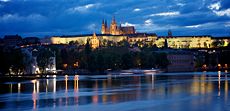
The Czech economy gets a substantial income from tourism: in 2001, the total earnings from tourism reached 118.13 billion CZK, making up 5.5% of GNP and 9.3% of overall export earnings. The industry employs more than 110,000 people - over 1% of the population.[38]
There are several centres of tourist activity: The historic city of Prague is the primary tourist attraction, and the city is also the most common point of entry for tourists visiting other parts of the country.[39] Most other cities in the country attract significant numbers of tourists, but the spa towns such as Karlovy Vary, Mariánské Lázně and Františkovy Lázně are particularly popular holiday destinations. Other popular tourist sites are the many castles and chateaux, such as those at Karlštejn, Konopiště and Český Krumlov. Away from the towns, areas as Český ráj, Šumava and the Krkonoše Mountains attract visitors seeking outdoor pursuits.
The country is also famous for its love of puppetry and marionettes. The Pilsner style beer originated in western Bohemian city of Plzeň.
Culture
Cuisine
- See also: Czech cuisine

Czech cuisine is marked by a strong emphasis on meat dishes. Pork is quite common, and beef and chicken are also popular. Goose, duck, rabbit and wild game are served. Fish is rare, with the occasional exception of fresh trout, and carp, which is served at Christmas.
Aside from Slivovitz, Czech beer and wine, Czechs also produce two uniquely Czech liquors, Fernet Stock and Becherovka. Kofola is a non-alcoholic Czech soft drink somewhat similar in look and taste to Coca-Cola, which is also popular.
Sport
- See also: Czech Republic national football team
Sport plays a significant part in the life of many Czechs who are generally loyal supporters of their favourite teams or individuals. The two leading sports in the Czech Republic are football and ice hockey, both drawing the largest attention of both the media and supporters. The many other sports with professional leagues and structures include basketball, volleyball, handball, athletics, floorball and others. Sport is a source of strong waves of patriotism, usually rising several days or weeks before an event and sinking several days after. The events considered the most important by Czech fans are: the Ice Hockey World Championship, Olympic Ice hockey tournament, the Euro, the football World Cup and qualification matches for such events. In general, any international match of the Czech ice hockey or football national team draws attention, especially when played against a traditional rival: Germany in football; Russia, Sweden and Canada in ice hockey; and Slovakia in both.
Music
- See also: Music of the Czech Republic
Music in the Czech Republic has roots both in high-culture opera and symphony and in the traditional music of Bohemia and Moravia. Cross-pollination and diversity are important aspects of Czech music: Composers were often influenced by traditional music; jazz and bluegrass music have become popular; pop music often consisted of English language hits sung in Czech.
Literature
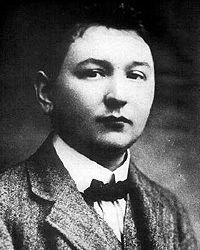
- See also: Czech literature
Czech literature is the literature of the historical regions of Bohemia, Moravia, and the Czech-speaking part of Silesia, (now part of the Czech Republic, formerly of Czechoslovakia). This most often means literature written by Czechs, in the Czech language, although Old Church Slavonic, Latin, and German were also used, mostly in the early periods. Modern authors from the Czech territory who wrote in other languages (e.g. German) are generally considered separately, and their writing usually existed in parallel with Czech-language literature and did not interact with it. Thus Franz Kafka, for example, who wrote in German (though he also knew Czech rather well), falls within Austrian literature, though he lived his entire life in Bohemia.
Czech literature is divided into several main time periods: the Middle Ages; the Hussite period; the years of re-Catholicization and the baroque; the Enlightenment and Czech reawakening in the 19th century; the avantgarde of the interwar period; the years under Communism and the Prague Spring; and the literature of the post-Communist Czech Republic. Czech literature and culture played a major role on at least two occasions when Czech society lived under oppression and no political activity was possible. On both of these occasions, in the early 19th century and then again in the 1960s, the Czechs used their cultural and literary effort to create political freedom and to establish a confident, politically aware nation.
International rankings
- Human Development Index 2007: Rank 32nd out of 178 countries
- Index of Economic Freedom 2007: Rank 31st out of 157 countries
- Reporters Without Borders worldwide press freedom index 2007: Rank 14th out of 169 countries
- Global Competitiveness Report 2006: Rank 29th out of 125 countries
- Democracy Index (January 2007): Ranks 18th of 167 countries (the highest rank of functioning democracy along with only 27 others)
- It was also ranked as the highest alcohol-consuming nation by The Economist in 2006.
See also
|
Culture
|
References
- ↑ 1.0 1.1 1.2 1.3 "Czech Republic". International Monetary Fund. Retrieved on 2008-10-09.
- ↑ Oxford English Dictionary, second edition, Oxford University Press, 1989.
- ↑ http://www.libri.cz/databaze/dejiny/text/t98.html (in Czech)
- ↑ Velinger, Jan (2006-02-28). "World Bank Marks Czech Republic's Graduation to 'Developed' Status". Radio Prague. Retrieved on 2007-01-22.
- ↑ Statistics of the Human Development Report.
- ↑ http://www.askoxford.com/concise_oed/czech?view=uk Oxford English Dictionary
- ↑ Emperor Charles IV elected Greatest Czech of all time, Radio Prague
- ↑ The Přemyslid Dynasty - Czech republic
- ↑ The Annals of Jan Dlugosz
- ↑ The rise and fall of the Przemyslid Dynasty
- ↑ The flowering and the decline of the Czech medieval state
- ↑ The Thirty Years' War - Czech republic, www.czech.cz
- ↑ RP's History Online - Habsburgs
- ↑ Lánové rejstříky (1656 - 1711)
- ↑ Radio Praha - zprávy
- ↑ "Tab. 3 Národnost československých státních příslušníků podle žup a zemí k 15.2.1921" (PDF) (in Czech). Czech Statistical Office. Retrieved on 2007-06-02.
- ↑ Czech Statistic Office
- ↑ "Zjišťování národnosti ve sčítání lidu, domů a bytů v období 1921 - 2001" (PDF) (in Czech). Czech Statistical Office. Retrieved on 2007-05-24.
- ↑ Largest number of children since 1993 born in CzechRep last year, Czech.cz, March 20, 2008
- ↑ The History and Origin of the Roma
- ↑ British Immigration Aides Accused of Bias by Gypsies
- ↑ "Number of foreigners in the CR", Czech Statistics Office (3 June, 2008). Retrieved on 2008-06-23.
- ↑ Mongolian job brokers arrested in Czech Republic, charged with luring workers with false promises
- ↑ "Obyvatelstvo hlásící se k jednotlivým církvím a náboženským společnostem" (in Czech). Czech Statistical Office. Retrieved on 2006-12-19.
- ↑ "Eurobarometer on Social Values, Science and technology 2005 - page 11" (PDF). Retrieved on 2007-05-05.
- ↑ "Social values, Science and Technology" (PDF). Eurobarometer (June 2005). Retrieved on 2006-12-19.
- ↑ 27.0 27.1 27.2 27.3 The Economist: Czechs with few mates
- ↑ The death of the districts, Radio Prague January 3, 2003.
- ↑ Getting to know Czech Republic, from Czech.cz, the official site of the Czech Republic
- ↑ World Bank 2007
- ↑ "Czech Republic to join Schengen". The Prague Post (2006-12-13). Retrieved on 2007-10-08.
- ↑ "Czech government adopts euro adoption plan". EUbusiness (2007-04-11). Retrieved on 2007-06-01.
- ↑ OECD.org
- ↑ 2007 WiFi survey EN
- ↑ openspectrum.info - Czech Republic
- ↑ "Wi-Fi: Poskytovatelé bezdrátového připojení". internetprovsechny.cz. Retrieved on 2008-03-17.
- ↑ "Bezdrátové připojení k internetu". bezdratovepripojeni.cz. Retrieved on 2008-05-18.
- ↑ "Promotion Strategy of the Czech Republic in 2004 - 2010". Czech Tourism. Retrieved on 2006-12-19.
- ↑ "CZECH SIGHTS". Discover Czech. Retrieved on 2006-12-19.
- Some of the material comes from the CIA World Factbook 2000 and the 2003 U.S. Department of State website.
External links
- Czech Republic
- Expats Radio Online Free online radio from the centre of Europe specifically for expatriates
- Government
- Parliament
- News
- Czech News Agency news
- Czech Republic Newspapers
- Prague Daily Monitor
- The Prague Tribune
- Radio Prague
- Statistics
Aktualne.cz CzechNews
- Photos
- Travelling
- CzechTourism
- Czech Republic at Wikitravel
|
|
|||||||
|---|---|---|---|---|---|---|---|
|
|||||||
|
|||||||||||
